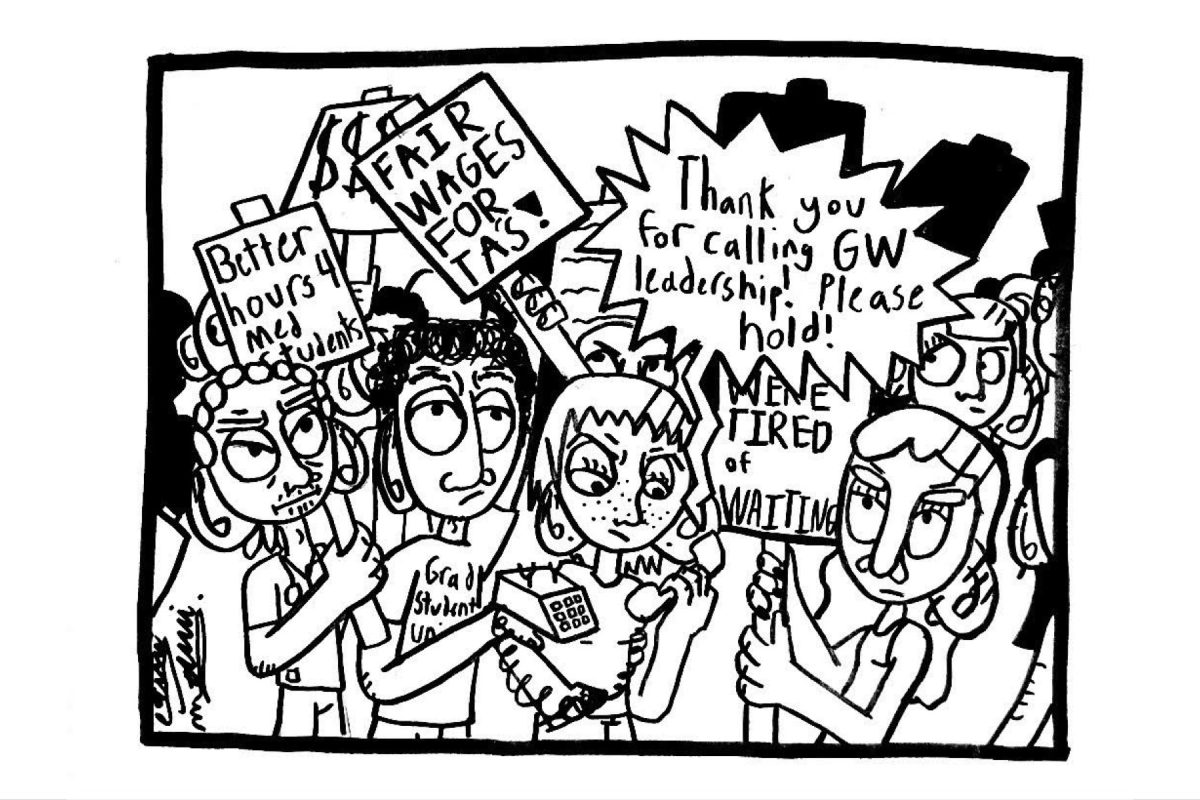GW and the Foggy Bottom area have seen a rise in groups launching unionization efforts in the past year, from graduate students and museum employees to School of Medicine & Health Sciences residents and fellows and GW Hospital nurses and service workers. For some groups, the launch of union efforts isn’t novel — it’s a revival. We have watched attempts to unionize among resident advisers and graduate students in the past, unsuccessful in part due to officials’ unwillingness to bargain or offer recognition. When engaging with new or revived union efforts across campus, officials should take notes from GW’s past.
Unions in higher education, especially among graduate student workers, have soared across the country in the past decade, mostly because graduate students have brought up concerns about wages, benefits and working conditions. Graduate student unions have surged by 133 percent since 2012, with 38 percent of graduate students now unionized across the U.S. GW is experiencing these efforts firsthand.
In fall 2017, graduate student employees at GW started to push for a union due to concerns about low wages, poor health care benefits and issues with work schedules and hours. They argued that their working conditions were inextricably tied to the “learning conditions” of the undergraduate students they teach and help, noting that they can’t give their best to the University when they’re “overworked and underpaid.” Graduate students were hopeful about the efforts because they came on the heels of a recent National Labor Relations Board ruling on Columbia University in 2016 that set a precedent of forming graduate student unions at private universities.
But in spring 2018, GW chose not to recognize the graduate student union on campus, with officials saying it would “limit” the support they can offer students and “disrupt the mentoring opportunities” between faculty advisers and graduate students. GW initially declined to meet with students, saying that in place of unionization or bargaining, graduate students could have different “mechanisms” to flag their concerns to the University, though officials didn’t explicitly state what those methods would be. When graduate students did eventually meet with officials, the meeting was unproductive, with no demands being addressed. Officials only met with students after they had held an hourlong sit-in at Rice Hall, following more than six months of attempts to unionize and set up meetings with administrators.
But this resistance wasn’t new. Unionization efforts among graduate students have always been met with opposition, especially at private universities where the NLRB would intervene and have the last say in the efforts. GW officials said they would “participate” in the process of unionization only if the graduate students got the NLRB involved — likely knowing the NLRB would oppose it because it wasn’t usually in favor of unions under a Republican administration.
Graduate students became wary that if they continued pushing for the unions and got the NLRB involved, it might end up overturning its Columbia decision and set back private universities across the country, so they ceased their efforts. But earlier this month, graduate students at GW started up their efforts again, which had been dormant for about six years.
Officials may not have recognized past unionization efforts among the student body, but that doesn’t mean they can’t do so now. Unionization demands often stem from a feeling of being unheard and unconsidered. Graduate students said in 2017 they wanted a voice. If they are reviving their attempts to unionize after the standstill they faced years ago, it means that the working conditions have not sufficiently changed. Earlier this month, some graduate students said they feel “under-respected” — echoing similar sentiments to those of graduate students from years past.
So let’s reopen the discussion. Unionization is a conversation, not an effort to overthrow GW’s leadership. Allowing your workers to unionize doesn’t mean everything will change overnight. And graduate students, who often contribute to immense amounts of research and scholarship, are the ones who help preserve GW’s status as a top research university — and probably helped the University land that cushy membership in the Association of American Universities, an invitation-only association for the top research universities, in 2023. This time around, GW should avoid repeating its past mistakes of allowing students’ demands to reach a boiling point and instead communicate openly with graduate students who want to unionize.
But campus history and GW’s current bargaining progress with other unions doesn’t make us optimistic. Last year, GW Textile Museum employees voted to unionize, requesting pay equity across the museum that matches the cost of living in D.C. But a year since the vote, employees are reporting slow bargaining with officials. Since SMHS residents and fellows voted to unionize last year, they’ve reported a lack of communication from the University — making progress on “noneconomic proposals,” like grievance procedure, childcare and inclusivity proposals — but not on the financial ones.
GW officials have made a step in the right direction by deciding to converse with union members, but this is the bare minimum. If GW wants to avoid protests and other forms of public activism for labor demands, they must show a concerted good-faith effort in hashing it out with groups who want to unionize. Officials shouldn’t be slow to respond to workers’ concerns or ignore them entirely as they’ve done in the past. Instead, offer employees a seat at the bargaining table.
The editorial board consists of Hatchet staff members and operates separately from the newsroom. This week’s staff editorial was written by Opinions Editor Andrea Mendoza-Melchor based on discussions with Contributing Social Media Director Anaya Bhatt, Culture Editor Nick Perkins and Sports Columnist Sydney Heise.



